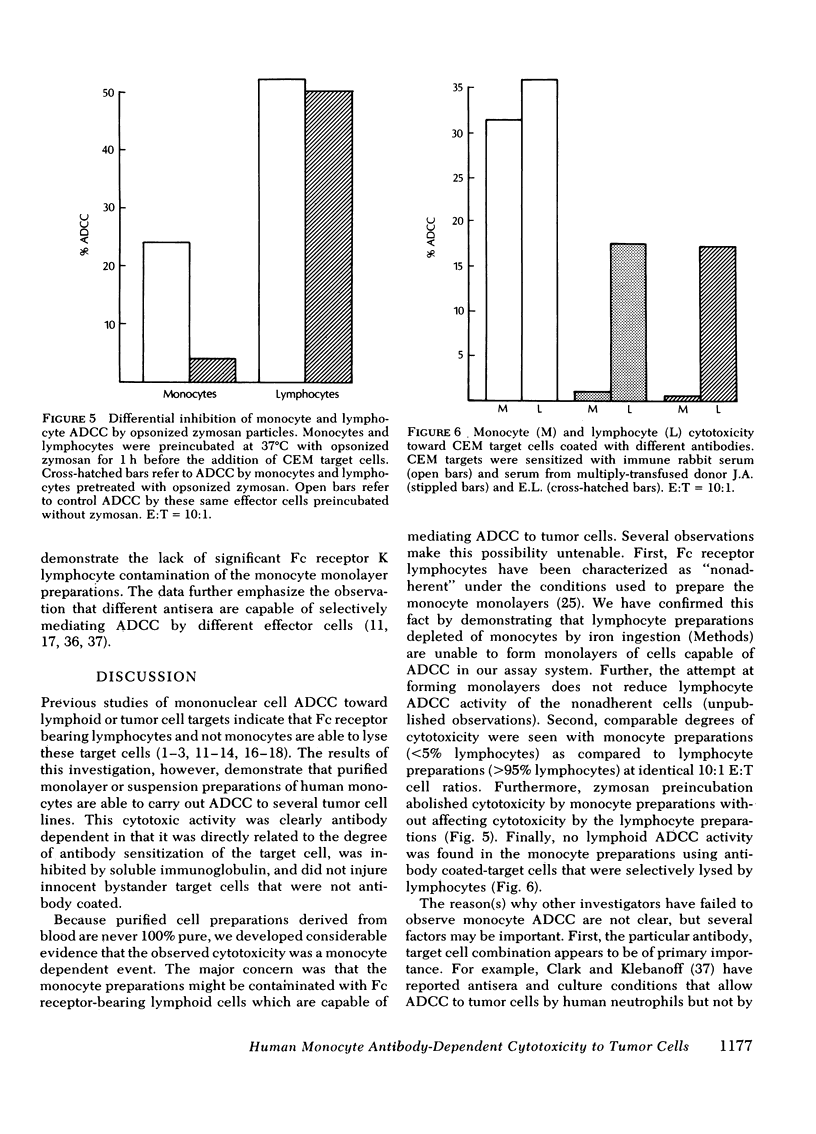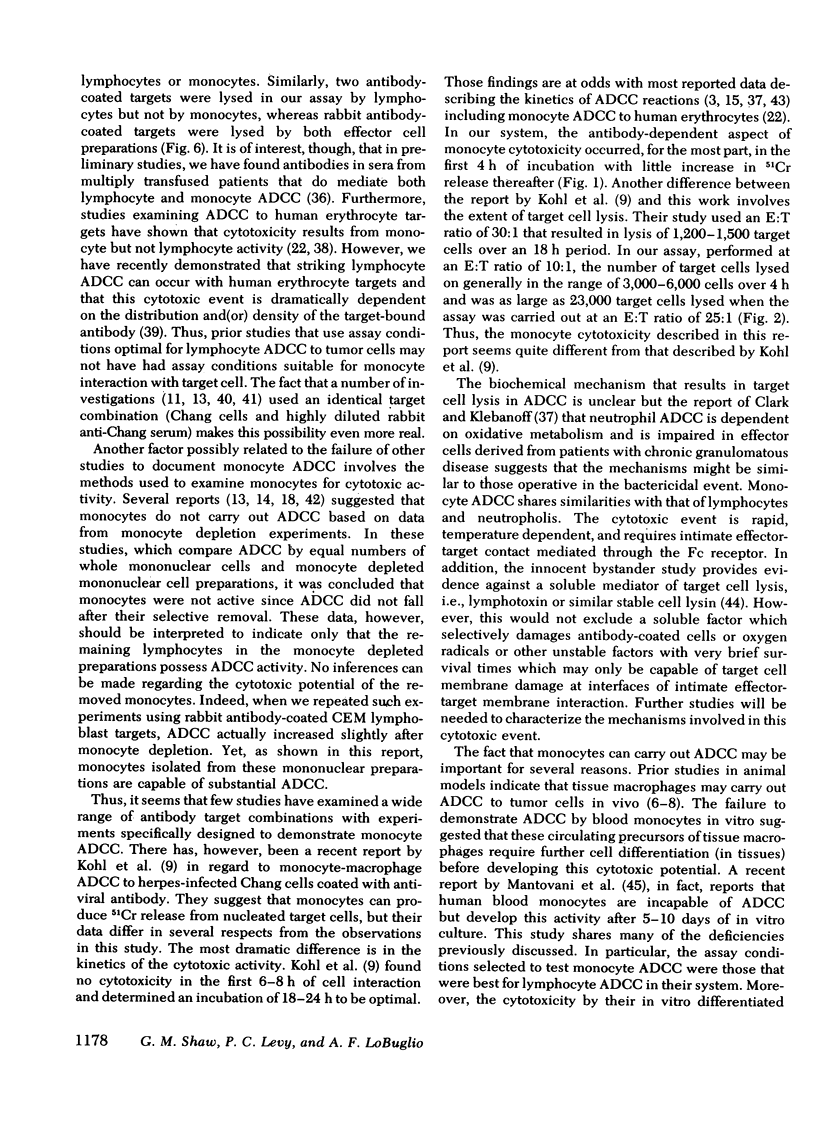Abstract
Previous investigations of mononuclear cell antibody-dependent cell-mediated cytotoxicity (ADCC) toward tumor cells suggest that K lymphocytes and not monocytes are active in this cytotoxic reaction. This report, however, demonstrates that human monocytes are able to carry out ADCC toward three different human tumor cell lines (CEM T lymphoblasts, Raji bone marrow-derived (B) lymphoblasts, and HeLa cells). The cytolytic event was found to be temperature dependent and rapid, with most of the lysis occurring in the first 4 h of incubation. The extent of lysis was directly related to the number of monocytes (effector cells) and to the degree of antibody sensitization of the target cells. The antibody-dependent cell contact-mediated nature of the cytolytic event was confirmed by inhibition with competing nonspecific monomeric immunoglobulin and by the ability of monocytes in “innocent bystander” experiments to lyse antibody-coated targets but not nonantibody-coated target cells. Evidence that monocytes were clearly the effector cells in the monocyte preparations included the observation that preincubation of effector cells with opsonized zymosan particles abolished ADCC by monocytes, but had little effect on lymphocyte ADCC. Furthermore, no evidence for Fc receptor K lymphocyte contamination of the monocyte preparations was found using antibody-coated target cells that were selectively lysed by lymphocytes but not monocytes. We suggest that ADCC toward tumor cell targets may prove to be a useful assay of monocyte function in normal and disease states.
Full text
PDF








Selected References
These references are in PubMed. This may not be the complete list of references from this article.
- Abramson N., Lo Buglio A. F., Jandl J. H., Cotran R. S. The interaction between human monocytes and red cells. Binding characteristics. J Exp Med. 1970 Dec 1;132(6):1191–1206. doi: 10.1084/jem.132.6.1191. [DOI] [PMC free article] [PubMed] [Google Scholar]
- Bankhurst A. D., Hastain E., Husby G., Diaz-Jouanen E., Williams R. C., Jr Human lymphocyte subpopulations defined by double surface markers. J Lab Clin Med. 1978 Jan;91(1):15–23. [PubMed] [Google Scholar]
- Bøyum A. Isolation of lymphocytes, granulocytes and macrophages. Scand J Immunol. 1976 Jun;Suppl 5:9–15. [PubMed] [Google Scholar]
- Calder E. A., Penhale W. J., McLeman D., Barnes E. W., Irvine W. J. Lymphocyte-dependent antibody-mediated cytotoxicity in Hashimoto thyroiditis. Clin Exp Immunol. 1973 Jun;14(2):153–158. [PMC free article] [PubMed] [Google Scholar]
- Clark R. A., Klebanoff S. J. Studies on the mechanism of antibody-dependent polymorphonuclear leukocyte-mediated cytotoxicity. J Immunol. 1977 Oct;119(4):1413–1418. [PubMed] [Google Scholar]
- Eccles S. A., Alexander P. Macrophage content of tumours in relation to metastatic spread and host immune reaction. Nature. 1974 Aug 23;250(5468):667–669. doi: 10.1038/250667a0. [DOI] [PubMed] [Google Scholar]
- FOLEY G. E., LAZARUS H., FARBER S., UZMAN B. G., BOONE B. A., MCCARTHY R. E. CONTINUOUS CULTURE OF HUMAN LYMPHOBLASTS FROM PERIPHERAL BLOOD OF A CHILD WITH ACUTE LEUKEMIA. Cancer. 1965 Apr;18:522–529. doi: 10.1002/1097-0142(196504)18:4<522::aid-cncr2820180418>3.0.co;2-j. [DOI] [PubMed] [Google Scholar]
- Gale R. P., Zighelboim J. Polymorphonuclear leukocytes in antibody-dependent cellular cytotoxicity. J Immunol. 1975 Mar;114(3):1047–1051. [PubMed] [Google Scholar]
- Haskill J. S. ADCC effector cells in a murine adenocarcinoma. I. Evidence for blood-borne bone-marrow-derived monocytes. Int J Cancer. 1977 Sep 15;20(3):432–440. doi: 10.1002/ijc.2910200316. [DOI] [PubMed] [Google Scholar]
- Haskill J. S., Fett J. W. Possible evidence for antibody-dependent macrophage-mediated cytotoxicity directed against murine adenocarcinoma cells in vivo. J Immunol. 1976 Nov;117(5 PT2):1992–1998. [PubMed] [Google Scholar]
- Horwitz D. A., Garrett M. A. Distinctive functional properties of human blood L lymphocytes: a comparison with T lymphocytes, B lymphocytes, and monocytes. J Immunol. 1977 May;118(5):1712–1721. [PubMed] [Google Scholar]
- Johnson R. J., Pasternack G. R., Shin H. S. Antibody-mediated suppression of tumor growth. II. Macrophage and platelet cooperation with murine IgG1 isolated from alloantiserum. J Immunol. 1977 Feb;118(2):494–497. [PubMed] [Google Scholar]
- Kaplan J., Shope T. C., Peterson W. D., Jr Epstein-barr virus-negative human malignant T-cell lines. J Exp Med. 1974 May 1;139(5):1070–1076. doi: 10.1084/jem.139.5.1070. [DOI] [PMC free article] [PubMed] [Google Scholar]
- Kay H. D., Bonnard G. D., West W. H., Herberman R. B. A functional comparison of human Fc-receptor-bearing lymphocytes active in natural cytotoxicity and antibody-dependent cellular cytotoxicity. J Immunol. 1977 Jun;118(6):2058–2066. [PubMed] [Google Scholar]
- Kohl S., Starr S. E., oleske J. M., Shore S. L., Ashman R. B., Nahmias A. J. Human monocyte-macrophage-mediated antibody-dependent cytotoxicity to herpes simplex virus-infected cells. J Immunol. 1977 Mar;118(3):729–735. [PubMed] [Google Scholar]
- Koller C. A., King G. W., Hurtubise P. E., Sagone A. L., LoBuglio A. F. Characterization of glass adherent human mononuclear cells. J Immunol. 1973 Nov;111(5):1610–1612. [PubMed] [Google Scholar]
- Kurlander R. J., Rosse W. F., Logue G. L. Quantitative influence of antibody and complement coating of red cells on monocyte-mediated cell lysis. J Clin Invest. 1978 May;61(5):1309–1319. doi: 10.1172/JCI109048. [DOI] [PMC free article] [PubMed] [Google Scholar]
- LoBuglio A. F., Cotran R. S., Jandl J. H. Red cells coated with immunoglobulin G: binding and sphering by mononuclear cells in man. Science. 1967 Dec 22;158(3808):1582–1585. doi: 10.1126/science.158.3808.1582. [DOI] [PubMed] [Google Scholar]
- Mantovani A., Caprioli V., Gritti P., Spreafico F. Human mature macrophages mediate antibody-dependent cellular cytotoxicity on tumour cells. Transplantation. 1977 Oct;24(4):291–293. doi: 10.1097/00007890-197710000-00010. [DOI] [PubMed] [Google Scholar]
- Melewicz F. M., Shore S. L., Ades E. W., Phillips D. J. The mononuclear cell in human blood which mediates antibody-dependent cellular cytotoxicity to virus-infected target cells. II. Identification as a K cell. J Immunol. 1977 Feb;118(2):567–573. [PubMed] [Google Scholar]
- Nelson D. L., Bundy B. M., Pitchon H. E., Blaese R. M., Strober W. The effector cells in human peripheral blood mediating mitogen-induced cellular cytotoxicity and antibody-dependent cellular cytotoxicity. J Immunol. 1976 Nov;117(5 Pt 1):1472–1481. [PubMed] [Google Scholar]
- Nelson D. L., Bundy B. M., Strober W. Spontaneous cell-mediated cytotoxicity by human peripheral blood lymphocytes in vitro. J Immunol. 1977 Oct;119(4):1401–1405. [PubMed] [Google Scholar]
- Ortaldo J. R., Bonnard G. D., Herberman R. B. Cytotoxic reactivity of human lymphocytes cultured in vitro. J Immunol. 1977 Oct;119(4):1351–1357. [PubMed] [Google Scholar]
- Pollack S., Heppner G., Brawn R. J., Nelson K. Specific killing of tumor cells in vitro in the presence of normal lymphoid cells and sera from hosts immune to the tumor antigens. Int J Cancer. 1972 Mar 15;9(2):316–323. doi: 10.1002/ijc.2910090209. [DOI] [PubMed] [Google Scholar]
- Poplack D. G., Bonnard G. D., Holiman B. J., Blaese R. M. Monocyte-mediated antibody-dependent cellular cytotoxicity: a clinical test of monocyte function. Blood. 1976 Dec;48(6):809–816. [PubMed] [Google Scholar]
- Romano P. J., Mann D. L. Specific MLC stimulation by cultured B cells. Tissue Antigens. 1976 Jul;8(1):9–12. doi: 10.1111/j.1399-0039.1976.tb00545.x. [DOI] [PubMed] [Google Scholar]
- Romano T. J., Shore S. L. Lysis of virus-infected target cells by antibody-dependent cellular cytotoxicity. I. General requirements of the reaction and temporal relationship between lethal hits and cytolysis. Cell Immunol. 1977 Apr;30(1):66–81. doi: 10.1016/0008-8749(77)90048-x. [DOI] [PubMed] [Google Scholar]
- Rosenblatt J., Zeltzer P. M., Portaro J., Seeger R. C. Inhibition of antibody-dependent cellular cytotoxicity by protein A from Staphylococcus aureus. J Immunol. 1977 Mar;118(3):981–985. [PubMed] [Google Scholar]
- Sanal S. O., Buckley R. H. Antibody-dependent cellular cytotoxicity in primary immunodeficiency diseases and with normal leukocyte subpopulations. Importance of the type of target. J Clin Invest. 1978 Jan;61(1):1–10. doi: 10.1172/JCI108907. [DOI] [PMC free article] [PubMed] [Google Scholar]
- Shaw G. M., Levy P. C., LoBuglio A. F. Human lymphocyte antibody-dependent cell-mediated cytotoxicity (ADCC) toward human red blood cells. Blood. 1978 Oct;52(4):696–705. [PubMed] [Google Scholar]
- Shin H. S., Kaliss N., Borenstein D., Gately M. K. Antibody-mediated suppression of grafted lymphoma cells. II. Participation of macrophages. J Exp Med. 1972 Aug 1;136(2):375–380. doi: 10.1084/jem.136.2.375. [DOI] [PMC free article] [PubMed] [Google Scholar]
- Shore S. L., Melewicz F. M., Gordon D. S. The mononuclear cell in human blood which mediates antibody-dependent cellular cytotoxicity to virus-infected target cells. I. Identification of the population of effector cells. J Immunol. 1977 Feb;118(2):558–566. [PubMed] [Google Scholar]
- Silverberg S. G., Chitale A. R., Hind A. D., Frazier A. B., Levitt S. H. Sinus histiocytosis and mammary carcinoma. Study of 366 radical mastectomies and an historical review. Cancer. 1970 Dec;26(6):1177–1185. doi: 10.1002/1097-0142(197012)26:6<1177::aid-cncr2820260602>3.0.co;2-d. [DOI] [PubMed] [Google Scholar]
- Ting A., Terasaki P. I. Influence of lymphocyte-dependent antibodies on human kidney transplants. Transplantation. 1974 Oct;18(4):371–373. [PubMed] [Google Scholar]
- Trinchieri G., Bauman P., De Marchi M., Tökés Z. Antibody-dependent cell-mediated cytotoxicity in humans. I. Characterization of the effector cell. J Immunol. 1975 Jul;115(1):249–255. [PubMed] [Google Scholar]
- Weiss S. J., King G. W., LoBuglio A. F. Superoxide generation by human monocytes and macrophages. Am J Hematol. 1978;4(1):1–8. doi: 10.1002/ajh.2830040102. [DOI] [PubMed] [Google Scholar]
- Yamamura Y. Immunologic responses to a murine mammary adenocarcinoma. II. Monocyte effector activation by humoral factors. Int J Cancer. 1977 May 15;19(5):717–724. doi: 10.1002/ijc.2910190518. [DOI] [PubMed] [Google Scholar]
- Yust I., Wunderlich J. R., Mann D. L., Buell D. N. Cytotoxicity mediated by human lymphocyte-dependent antibody in a rapid assay with adherent target cells. J Immunol. 1973 Jun;110(6):1672–1681. [PubMed] [Google Scholar]
- Yust I., Wunderlich J. R., Mann D. L., Terry W. D. Identification of lymphocyte-dependent antibody in sera from multiply transfused patients. Transplantation. 1974 Aug;18(2):99–107. doi: 10.1097/00007890-197408000-00002. [DOI] [PubMed] [Google Scholar]
- Ziegler H. K., Henney C. S. Studies on the cytotoxic activity of human lymphocytes. II. Interactions between IgG and Fc receptors leading to inhibition of K cell function. J Immunol. 1977 Sep;119(3):1010–1017. [PubMed] [Google Scholar]


